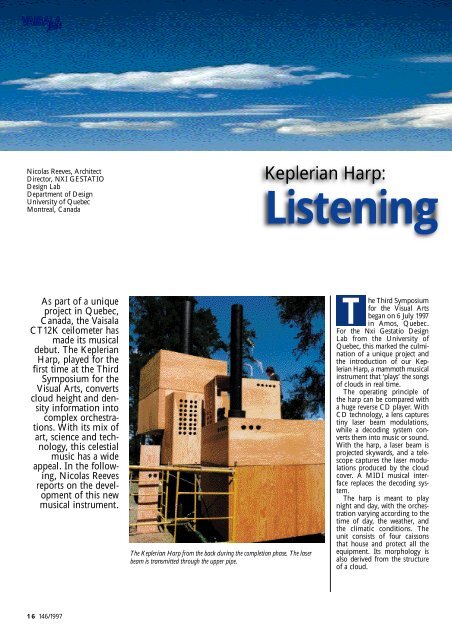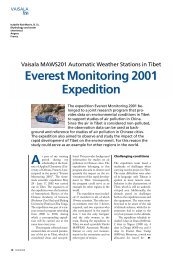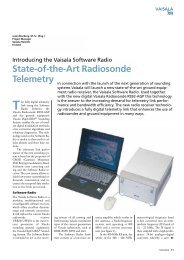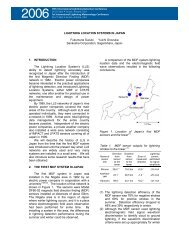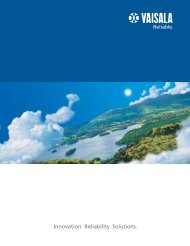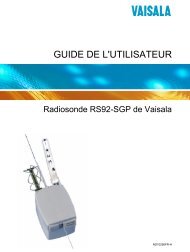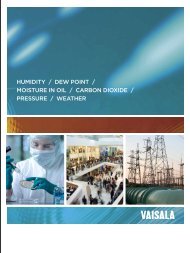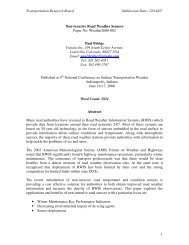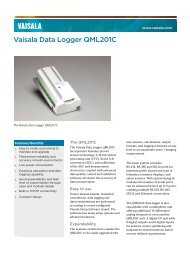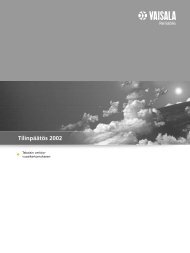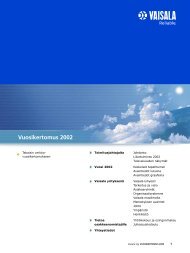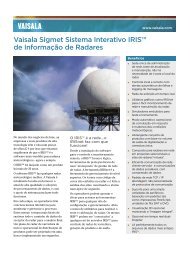Listening to Cloud Songs - Vaisala
Listening to Cloud Songs - Vaisala
Listening to Cloud Songs - Vaisala
You also want an ePaper? Increase the reach of your titles
YUMPU automatically turns print PDFs into web optimized ePapers that Google loves.
Nicolas Reeves, Arch i t e c t<br />
D i r e c t o r, NXI GES TAT IO<br />
Design La b<br />
D e p a rtment of Design<br />
University of Quebec<br />
M o n t r e a l, Canada<br />
Keplerian Harp:<br />
L i s t e n i n g<br />
As part of a unique<br />
project in Quebec,<br />
C a n a d a, the Va i sa l a<br />
C T 12K ceilometer has<br />
made its musical<br />
d e b u t. The Keplerian<br />
H a r p, played for the<br />
first time at the Th i r d<br />
Symposium for the<br />
Visual Art s, conv e rt s<br />
cloud height and density<br />
information in<strong>to</strong><br />
complex orch e s t r a-<br />
t i o n s. With its mix of<br />
a rt, science and techn<br />
o l o g y, this celestial<br />
music has a wide<br />
a p p e a l. In the followi<br />
n g, Nicolas Reeves<br />
r e p o rts on the development<br />
of this new<br />
musical instrument.<br />
The Keplerian Harp from the ba ck during the completion phase. The laser<br />
beam is transmitted through the upper pipe.<br />
T<br />
he Third Symposium<br />
for the Visual Art s<br />
b e gan on 6 July 1997<br />
in Amos, Quebec.<br />
For the Nxi Gestatio Design<br />
Lab from the University of<br />
Q u e b e c, this marked the culmination<br />
of a unique project and<br />
the introduction of our K e p-<br />
lerian Harp, a mammoth mus i c a l<br />
instrument that ‘plays’ the songs<br />
of clouds in real time.<br />
The operating principle of<br />
the harp can be compared with<br />
a huge reverse CD player. Wi t h<br />
CD tech n o l o g y, a lens captures<br />
t i ny laser beam modulations,<br />
while a decoding system conv<br />
e rts them in<strong>to</strong> music or sound.<br />
With the harp, a laser beam is<br />
projected skyw a r d s, and a telescope<br />
captures the laser modulations<br />
produced by the cloud<br />
c o v e r. A MIDI musical interface<br />
replaces the decoding syst<br />
e m.<br />
The harp is meant <strong>to</strong> play<br />
night and day, with the orch e s-<br />
tration varying according <strong>to</strong> the<br />
time of day, the weather, and<br />
the climatic conditions. Th e<br />
unit consists of four caissons<br />
that house and protect all the<br />
e q u i p m e n t. Its morphology is<br />
also derived from the structure<br />
of a cloud.<br />
16 146/1997
<strong>to</strong> <strong>Cloud</strong> So n g s<br />
The complete Keplerian Harp team ( from the left): Mario Tr u d e l, Catherine Lambert, Celine Bietlot,<br />
Nicolas Reev e s, Chryso Ba s h o n g a, Bilal Jamous and Se bastien Duceppe.<br />
Last-minute search<br />
for a ceilometer<br />
The hardest part of the project<br />
was <strong>to</strong> find an appropriate laser/<br />
telescope combination. To avoid<br />
the need for fine-tuned adjustments<br />
and alignment, we decided<br />
on an integrated system. A Canadian<br />
research center promised the<br />
loan of a powerful lidar, and the<br />
harp was designed accordingly.<br />
U n f o rt u n a t e , l ythe lidar became<br />
unavailable just a few weeks before<br />
the Symposium.<br />
At this point, we started making<br />
urgent telephone calls <strong>to</strong> lidar<br />
manufacturers and research centers<br />
– any place that could spare a<br />
lidar or ceilometer for a few<br />
w e e ks. Although intrigued by<br />
our project, no one was able <strong>to</strong><br />
provide a lidar at such short<br />
notice. We spent a full week on<br />
the phone and Internet. Finally,<br />
we found a solution <strong>to</strong> our problem<br />
– in the form of an e-m a i l<br />
m e ssage from Mr. Selwyn Alpert<br />
at Va isala’s office in Wo b u r n,<br />
M a s sa chusetts (US A) .<br />
S p e a king for everyone at the<br />
lab, I cannot overemphasize the<br />
kindness and helpful attitude of<br />
M r. Alpert, who unders<strong>to</strong>od<br />
our desperate situation and obtained<br />
a CT12K ceilometer for<br />
us within just a few days.<br />
Pe r f ect solution<br />
for the harp<br />
We knew the CT12K because<br />
our neighbour, McGill University<br />
in Montreal, has one installed<br />
on their roof. We were impressed<br />
with the ruggedness of<br />
this instrument, which can operate<br />
year-round in Quebec’s extreme<br />
weather conditions.<br />
U n l i ke other turnkey syst<br />
e m s, the CT12K is not blinded<br />
by certain atmospheric conditions<br />
such as heavy rain or hail.<br />
This was another key fac<strong>to</strong>r,<br />
since everyone was curious <strong>to</strong><br />
hear the music generated by a<br />
massive thunders<strong>to</strong>rm or even a<br />
h e a vy blizzard.<br />
Two other features of the system<br />
were also import a n t. Standard<br />
connections allow easy conf<br />
i g u r a t i o n, and the infrared<br />
beam – a low power, pulsed<br />
laser – is much safer <strong>to</strong> use than<br />
a regular beam. In addition, the<br />
output serial port provides<br />
A SCII messa g e s, so there is no<br />
need for an expensive data<br />
acquisition card, and we did not<br />
have <strong>to</strong> write a new driver.<br />
Once the lidar was installed,<br />
we plunged in<strong>to</strong> the operation<br />
m a n u a l, made all the connections<br />
– and the data began flowing<br />
in<strong>to</strong> the computer.<br />
C o n verting clouds<br />
<strong>to</strong> music<br />
We knew then that the harp<br />
would be ready on schedule, but<br />
there was still a lot of work <strong>to</strong> be<br />
done. The cloud-t o -music interfacing<br />
software was the core of<br />
146/1997 17
Nicolas Reeves talks with Montreal composer Helmut Lipsky.<br />
our instrument, and since the<br />
C T 12K was different from the<br />
system we originally planned <strong>to</strong><br />
use, we had <strong>to</strong> re-write parts of<br />
our software.<br />
The main difference was the<br />
f r e q u e n cy of data transmission.<br />
The CT12K delivers a messa g e<br />
e v e ry thirty seconds, with each<br />
m e s sage providing a maximum<br />
of five or six ‘m u s i c -u sa b l e ’<br />
n u m b e r s. To produce the simplest<br />
kind of music, we needed<br />
about eight thousand numbers<br />
per minute. Ev e ry note requires<br />
about twenty parameters, and<br />
we wanted <strong>to</strong> be able <strong>to</strong> play up<br />
<strong>to</strong> eight notes per second.<br />
To solve the problem, we had<br />
<strong>to</strong> reconstitute the cloud variations<br />
between the messa g e s. We<br />
developed a simple fractal equation<br />
that allowed us <strong>to</strong> produce<br />
the required amount of data<br />
after a few minutes of scanning.<br />
Later we learned that our art -<br />
inspired method has already<br />
been used by several scientists –<br />
and that more complex equations<br />
had not proved better or<br />
more physically realistic.<br />
A selection of 228<br />
i n s t r u m e n t s<br />
The final software was designed<br />
with a user-friendly interf a c e<br />
allowing users <strong>to</strong> <strong>to</strong>ggle between<br />
two different displays.<br />
The cloud screen shows the<br />
lidar information, while the<br />
music screen displays musicrelated<br />
data, with the sixteen<br />
windows corresponding <strong>to</strong> one<br />
channel each.<br />
With this advanced software,<br />
the orchestrations can be freely<br />
saved and loaded. Five categories<br />
of cloud conditions have<br />
been assigned: clear sky, one or<br />
two cloud layers, partial cloud<br />
c o v e r, complete cloud cover.<br />
When the cloud cover ch a n g e s,<br />
the orchestration changes au<strong>to</strong>m<br />
a t i c a l l y.<br />
E a ch of the sixteen ch a n n e l s<br />
can play one of 228 instrum<br />
e n t s. Many of these instruments<br />
are already polyphonic,<br />
so at times the harp sounds like<br />
a complete orch e s t r a. The atmosphere<br />
can be divided in numerous<br />
altitude ranges, with each<br />
one corresponding <strong>to</strong> an instrumental<br />
section and mapped <strong>to</strong> a<br />
c e rtain frequency interv a l. An<br />
altitude of 0 <strong>to</strong> 600 feet can be<br />
r e s e rved for the percussion, for<br />
example; 400 <strong>to</strong> 1000 feet, for<br />
the brass; 1000 <strong>to</strong> 1100 feet, for<br />
the timpani; 1000 <strong>to</strong> 2000, for<br />
the violins and cellos; and so<br />
o n, up <strong>to</strong> maximum altitude<br />
range of 12,500 feet. In this way,<br />
the atmosphere becomes a huge<br />
musical score.<br />
The MIDI interface divides<br />
the range of frequencies in<strong>to</strong><br />
128 notes, from 0 <strong>to</strong> 127, separated<br />
by half-<strong>to</strong>ne interv a l s.<br />
Noting this, we decided <strong>to</strong> associate<br />
an altitude of 12,600 feet<br />
with a <strong>to</strong>tally obscured sky, and<br />
an altitude of 12 ,700 feet with<br />
clear conditions or with any<br />
cloud cover out of the lidar<br />
range. On this basis, we were<br />
able <strong>to</strong> define the fundamental<br />
harp setting, with each 10 0 -f o o t<br />
range mapped <strong>to</strong> one half-t o n e .<br />
Th u s, any person with a trained<br />
ear can ‘hear’ the height of the<br />
c l o u d.<br />
Orchestrations for<br />
various cloudscapes<br />
When we first started playing<br />
with the system, we set almost<br />
all the music parameters – volume,<br />
duration, tempo, length<br />
of the notes, etc. – <strong>to</strong> fixed valu<br />
e s. Only the note <strong>to</strong> be played<br />
was defined by the cloud. After<br />
we learned <strong>to</strong> recognize the<br />
sequences produced by different<br />
kinds of clouds, we let the<br />
cloud control more and more<br />
of the parameters.<br />
We spent hours experimenting<br />
with different orch e s t r a-<br />
t i o n s, trying <strong>to</strong> find arrangements<br />
particularly suited <strong>to</strong> different<br />
‘cloudscapes’. Ne e d l e s s<br />
<strong>to</strong> sa y, the experience was fascin<br />
a t i n g. At one point, we had<br />
defined a very primal and minimalist<br />
arrangement, simulating<br />
three wind flutes playing in the<br />
b a s s, bari<strong>to</strong>ne and tenor regist<br />
e r s. A heavy thunders<strong>to</strong>rm came<br />
u p, with lightning striking all<br />
around us, and almost continuous<br />
t h u n d e r. Surrounded by great<br />
p i n e s, with low-<strong>to</strong>ne rumbling<br />
f l u t e s, under cascades of water<br />
and a natural light show, this<br />
was a unique and awe-i n s p i r i n g<br />
e x p e r i e n c e .<br />
The debut performance for<br />
the general public triggered a<br />
mix of responses, from incredulity<br />
on the one hand <strong>to</strong> fascination<br />
on the other. Some people<br />
just could not believe that<br />
s u ch an instrument was possible:<br />
they looked for a hidden<br />
tape recorder in the unit. Th e<br />
great majority of people, howe<br />
v e r, appreciated this encounter<br />
between art, science and techn<br />
o l o g y, and the poetic background<br />
underlying the project.<br />
Wide-ranging plans<br />
for the future<br />
We have many plans for the<br />
future. By installing a visible<br />
laser beam near the lidar, we<br />
would like <strong>to</strong> show the audience<br />
where the laser enters and<br />
‘plays’ the cloud. We also plan<br />
<strong>to</strong> sample noises from the env i-<br />
r o n m e n t, allowing the harp <strong>to</strong><br />
play sequences that incorporate<br />
voices from the audience. Our<br />
final plan is <strong>to</strong> install a complete<br />
Keplerian Harp at a fixed<br />
l o c a t i o n. This harp will feature<br />
seven long-range vertical YA G<br />
laser beams at 20–50 meter<br />
i n t e rv a l s. The impact of these<br />
seven green beams is sure <strong>to</strong> be<br />
i m p r e s s i v e .<br />
All of these plans will require<br />
lidar equipment, the availability<br />
of which is uncert a i n. From the<br />
b e g i n n i n g, we knew that implementing<br />
the harp project would<br />
require partners with uncommon<br />
curiosity and an open<br />
m i n d.<br />
Although we are not sure<br />
w h i ch equipment we will use in<br />
the future, we would like <strong>to</strong><br />
continue with Va i sala instrum<br />
e n t s. Their compact size, sturd<br />
i n e s s, ease of use, flexibility<br />
and overall features, as well as<br />
the kindness of the Va i sala people<br />
in Wo b u r n, allowed us <strong>to</strong><br />
complete our project on time –<br />
<strong>to</strong> the great satisfaction of our<br />
audience and our design team.<br />
■<br />
The NXI GES TAT IO Design Lab is housed in the Pavilion of<br />
Design of the University of Quebec in Montreal. Directed by<br />
a r chitect Nicholas Reeves, the lab is dedicated <strong>to</strong> exploring the<br />
potential of computer information in the fields of arts (visual<br />
a rt s, media art s, literature, music), architecture and design.<br />
A rt i s t s, students and recent graduates from many countries<br />
have worked in the lab, for periods varying from two weeks <strong>to</strong><br />
one year.<br />
The Keplerian Harp project was conceived, designed and<br />
managed by Nicolas Reeves. The implementation team comprised<br />
Celine Bietlot, architect and engineer, from Belgium;<br />
C h ryso Bashonga, sculp<strong>to</strong>r and designer, from Zaïre; Bilal<br />
J a m o u s, programmer, from Lebanon; and Catherine La m b e rt,<br />
Mario Trudel and Sebastien Duceppe, design students, from<br />
C a n a d a.<br />
18 146/1997


